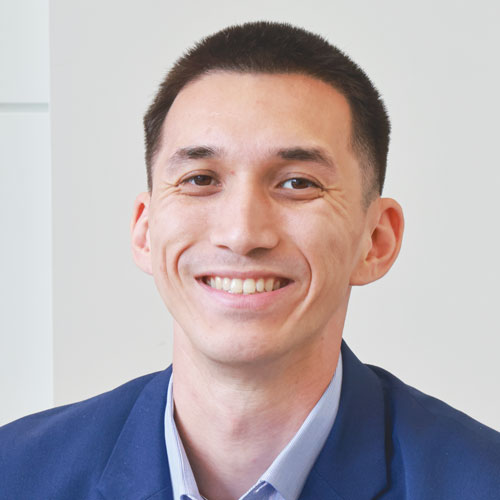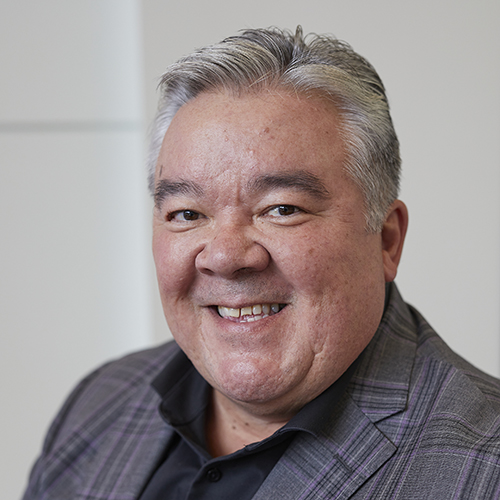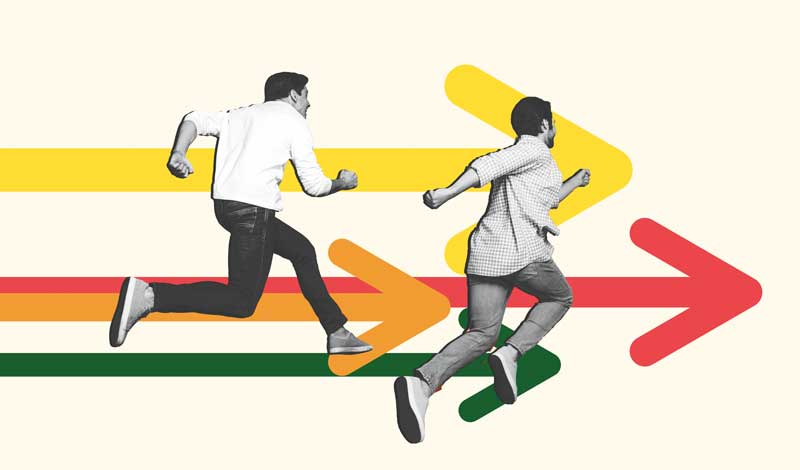The World Tribune sat down with SGI-USA Men’s Leader James Herrmann and SGI-USA Young Men’s Leader Kenichi Hackman to learn how the men and young men will unite this month and beyond by creating lasting friendships with young people.
Hi, Kenichi and James. At the Central Executive Committee Conference in June, the SGI-USA youth presented a bold vision of enabling 10,000 young people to receive the Gohonzon and join our movement by Ikeda Sensei’s 100th birthday in 2028. What is the heart behind that goal?

Kenichi Hackman: This year, we’ve been seeing a lot of chaos and tumult in society, and people are facing a lot of uncertainty and worry. With that reality in mind, the youth leaders discussed what it would look like if young people stood up and took responsibility for the happiness of themselves and of those in their environment—their families, their friends, their communities—based on Buddhist practice and helped 10,000 youth join our movement. It would change 10,000 communities in the U.S. It would change our world. So, we made up our minds. We vowed to make this vision a reality by 2028. And what better way to celebrate Sensei’s 100th birthday than by empowering many young people through Buddhist practice.
For that goal to be achieved, we understood that the current youth of the SGI-USA must first stand up in faith and make a strong determination to introduce their friends. I believe this will create ripples of change that will impact the next 50 years of kosen-rufu. We are not just fighting for numbers; we are creating a new history.

James Herrmann: Yes, I agree with Kenichi. We desperately need to change this country, and to do that, we need to make a solid impact on young people’s lives. Without youth rooted in Buddhist humanism, we don’t have a future in the SGI. The purpose is to build on the foundation that our mentor, Sensei, built here in America and establish a solid foundation in the SGI-USA for the future.
The SGI-USA announced their new motto for the year: “Creating a District With Many Youth Is Up to Me!” One of the major components of that goal is shakubuku rooted in friendship. Could you explain why that’s important?
Kenichi: Those of us who are practicing Buddhism right now have incredible faith experiences we can share with our friends. The underlying theme of that motto is not to wait for someone else to come along and “save my district” or “save us.” It is a call to each person to take ownership of revitalizing the district by increasing youth attendance. And that involves creating new friendships with young people. We each are the protagonists.
It can be difficult to build bonds with youth who may be distrustful for various reasons, but we all have something to offer to a young person—and that’s friendship. Maybe they start practicing, maybe they don’t, but we can be there for them for life.
August is men’s month. How can the young men’s and men’s division unite toward this vision of expanding the ranks of young people in our movement?
James: That’s a great question. First, we have to be in the right frame of mind and life condition to actually want to introduce or approach young people, then muster up the courage to do so. This is where I believe abundant daimoku to open our life and courageous action is most crucial.
We all have barriers in forming friendships with youth. Recently, I was at a meeting where a young men’s leader was talking about statistics in America. He asked the group at the meeting, “How many of you believe that young people don’t like organized religion?” Almost everyone raised their hand. Next, he asked, “How many of you believe youth prefer isolation over socialization?” Almost everyone raised their hand again. Then he asked, “How many of you have actually spoken to a youth recently?” And no one raised their hands.
We can talk about expanding our youth participation, but that’s dependent on how many youth we actually engage with, such as by saying “hello” to a young person at the grocery store or opening up a conversation with our young neighbors—taking concrete actions each day with the intention of developing friendships. Not for the sake of them simply receiving the Gohonzon. Young men are looking for role models, and I believe the men’s division members are perfect to assume that role.
Kenichi: This year, I’ve been listening to podcasts about young people. One podcast called “Lost Boys,” discusses why young men are struggling. One conclusion they made is that there is a lack of male role models in young men’s lives. If their dads aren’t around or if they don’t have a coach that they really look up to, young men don’t really have great male role models.
Listening to this, I developed a greater sense of appreciation for the SGI-USA and how we strive to come together as men and young men.
There are many men and young men in the SGI whom I found inspiring as great examples of what a man could be—people that were always there and showed up for me when I needed them the most. I feel like I met Sensei through the men’s division in my teenage years.
Thank you for sharing. A 2023 Surgeon General report revealed that for young people(ages 15 to 24), their in-person time with friends has dropped by nearly 70% in the past two decades.[1] You have visited young men all over the country. Do you find it to be the case that young men just want to be left alone?
James: No. I meet with a young men’s division member every week, and we both look forward to it. Some weeks we go meet with other young men together. One day, we visited this one young man who had been inactive in SGI activities for many years. My young friend called me beforehand and said: “Just bring your beads. Don’t bring The New Human Revolution. Don’t bring your publications. Our goal is to talk and chant three times with this guy.”
I just watched my youthful buddy patiently listening to this member. It was the biggest human revolution for me because, honestly, I was thinking, What are we talking about here? We spent over three-and-a-half hours at this person’s house.
But not only did we chant three times, we chanted for 20 minutes, did gongyo, and this person came to the next discussion meeting—all his idea. We just visited him this past Wednesday again. It’s been three months since our first visit, and his life has changed exponentially. He told us he wanted to receive the Gohonzon. I’m convinced it was the time we spent with him that gained his trust and changed his heart. I realized, if we really want to build trust and raise young people, it requires our most precious commodity, our time.
If we assume young people don’t want to engage with us, everything stops there. I haven’t met a young person that doesn’t want a friend. Human-to-human connection is the only thing that really transformed this one young man’s life.
Kenichi: I hear a lot of youth today say their social battery drains really fast. But at the end of the day when we say friendship, we are talking about friendship that gives energy and hope. Young men love authenticity and know when someone genuinely cares about them.
There’s this guy I met a couple weeks ago, a guest, who has been checking out the practice. A group of us had gone to play basketball at a local park. He was shooting by himself and asked us if we could play three-on-three.
So we started playing. After, we talked for over an hour and eventually shared our Buddhist practice with him. Since then, he’s been to a kosen-rufu gongyo meeting, a couple hangouts and plans to go to a discussion meeting this weekend. This is a guy who says his social battery drains really fast, but recently, couldn’t wait to hang out with us after he was done with a 12-hour student orientation. When we suggested trying chanting together, he said, “Man, I would really love that. I need that.”
Tell us about the first person you introduced to the practice?
James: The first person I shared Buddhism with was my childhood friend in Texas. We had just turned 15 when he began having difficulties at home. I encouraged him to chant, and soon after that he became a member. He was a groomsman at my wedding, and I introduced his family to Buddhism even though all of them didn’t end up practicing. While he is not actively practicing today, his Buddhist practice changed his entire perspective on life. We’re still good friends today.
Kenichi: The first person I developed friendship with and introduced was someone I met through my girlfriend. He was dating her sister. The four of us hung out often. After about a year and a half of getting to know him, I invited him to a young men’s meeting where we were going to play basketball. We both love basketball.
I was really leading with the basketball, but he said he’d love to come check out the meeting regardless of whether there was basketball. He told me, “I’ve seen how you are when we’re all hanging out with our girlfriends and their family, and I really trust you.” I wasn’t doing anything special, just washing dishes after dinner or taking out the trash, things I learned in Soka Group.
I supported him from his first meeting to when he received the Gohonzon over two years ago. Since then, our friendship has deepened. Actually, supporting him has enabled me to break through my own struggles, so I’m incredibly grateful for our friendship.
That’s great! What’s next?
James: Our first challenge in August is to exponentially increase the men’s attendance at the discussion meeting. Also, our focus this summer is for the men and the young men to start forming genuine friendships, moving one step closer toward our goal in 2028 with the men and young men united.
In that respect, it is important for the men’s division to root ourselves in Sensei’s guidance on how to foster capable people—through guidance, education, training and support.[2]
Kenichi: It’s up to the young men’s division to take the initiative together with the men’s division in creating a plan of action. Sensei has pointed out when these two divisions work together, our strength multiplies exponentially. He said:
Now is the time for the members of the men’s and young men’s divisions to unite their efforts and open a new page of kosen-rufu—combining the rich experience and conviction of the former, and the passion and initiative of the latter. If the two divisions work closely together, their strength will not merely double, but multiply exponentially. This will provide even greater momentum to kosen-rufu and, without a doubt, play a decisive role in building a youthful Soka Gakkai.[3]
August 1, 2025 World Tribune, pp. 6–7
You are reading {{ meterCount }} of {{ meterMax }} free premium articles

